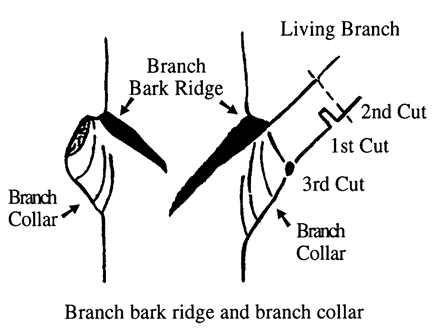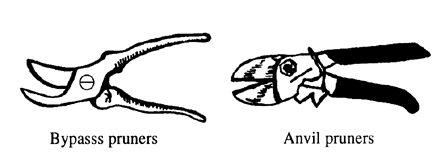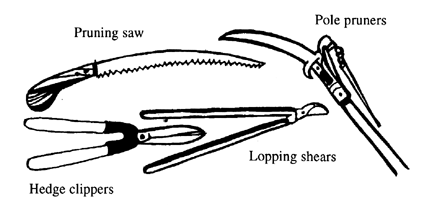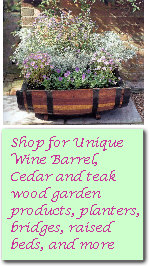Current pruning recommendations advise against pruning
branches flush to the trunk. Flush cutting is harmful in several ways: it
damages bark as pruning tools rub against the trunk, it removes the branch
collar , and goes behind the branch bark ridge.

The branch collar is the swollen area of trunk tissue that
forms around the base of a branch. If you prune away the branch collar, you
remove not only branch wood, but also trunk wood, opening the plant to more
extensive decay.
The branch bark ridge on trees is a line of rough bark running
from the branch-trunk crotch into the trunk bark. It is less prominent on some
trees than on others. The best pruning cut is made outside the branch collar
, at a 45 to 60 degree angle to the branch bark ridge. More detailed directions
for pruning deciduous and evergreen trees and shrubs can be found in specific
Extension publications.
Why Prune?
1) To improve the appearance or health of a plant.
Prompt removal of diseased, damaged, or dead plant parts speeds the formation of
callus tissue, and sometimes limits the spread of insects and disease. For
trees, pruning a dense canopy permits better air circulation and sunlight
penetration. To avoid future problems, remove crossing branches that rub or
interfere with each other, and those that form narrow crotches.
2) To control the size of a plant. Pruning reduces the
size of a plant so that it remains in better proportion with your landscape.
Pruning can also decrease shade, prevent interference with utility lines, and
allow better access for pest control.
3) To prevent personal injury or property damage.
Remove dead or hazardously low limbs to make underlying areas safer. Corrective
pruning also reduces wind resistance in trees. Prune shrubs with thorny branches
back from walkways and other well-traveled areas. Have trained or certified
arborists handle any pruning work in the crowns of large trees.
4) To train young plants. Train main scaffold branches
(those that form the structure of the canopy) to produce stronger and more
vigorous trees. You'll find it easier to shape branches with hand pruners when a
plant is young than to prune larger branches later. Pruning often begins with
young plants for bonsai, topiary, espalier, or other types of special plant
training.
5) To influence fruiting and flowering. Proper pruning
of flower buds encourages early vegetative growth. You can also use selective
pruning to stimulate flowering in some species, and to help produce larger
(though fewer) fruits in others.
6) To rejuvenate old trees and shrubs. As trees and
shrubs mature, their forms may become unattractive. Pruning can restore vigor,
and enhance the appearance of these plants.
What tools are needed?
Use hand pruners to cut stems up to 3/4 inches in diameter. Two types of
pruners are available: bypass and anvil. Bypass pruners have sharpened,
curved, scissors-type blades that overlap. Anvil pruners have straight
upper blades that cut against flat lower plates. Although anvil pruners are
usually cheaper, they tend to crush stems as they cut. Furthermore, the width of
the anvil can prevent you from reaching in to get a close cut on narrow-angled
stems. Due to these drawbacks, bypass pruners are generally recommended.

Use lopping shears to cut through branches that are up
to 1 3/4 inches in diameter. Loppers have long handles to give you extra reach
and better cutting leverage. For heavy duty pruning jobs, select loppers with
ratchet joints or those with gears. Also look for loppers with shock-absorbing
bumpers between the blades, to lessen arm fatigue. Again, bypass blades are
preferable.
Use pruning saws to remove stems you cannot cut with
hand pruners or lopping shears. Pruning saws come in many sizes, with either
straight or curved blades, and teeth that are either fine or coarse. Use a
finely-toothed, curved pruning saw to remove branches up to 2 1/2 inches in
diameter. You can make a clean cut with this type of saw where access is
difficult. Use a coarsly-toothed saw for heavy branches 3 inches or more in
diameter.
Use pole pruners to cut out-of-reach branches up to 2
inches in diameter. Pole pruners consist of blades attached to stationary hooks
which are mounted on long wooden or aluminum poles. A cord or chain is used to
control the cutting action of the spring- loaded blade. Fully extended, you can
use pole pruners to reach branches 12 feet or more in height. Pole pruners are
especially valuable on jobs where ladders would be inconvenient, or would damage
the tree. Use great care when pruning near utility lines.
Use chain saws to remove branches greater than 3 inches
in diameter. Many types and sizes of chain saws are readily available, powered
by gasoline or electricity. In selecting a chain saw, carefully consider the
tasks for which it will be used. The size of the engine and the length of the
blade determine the branch diameter through which you can cut. Chain saws
should be used only with appropriate safety gear by people who fully understand
their operation.
Use hedge clippers or pruning shears to trim
thin-stemmed hedges. Manual hedge clippers, and ones powered by gasoline or
electricity, are available. All types shear off growth in a straight line,
regardless of branch collar or bark ridge location. If you have a long hedge,
you may have to use hedge clippers when hand pruning is impractical. With
repeated shearing, hedges develop a profusion of outer twigs, die back in the
center, and often show an increase in pest problems.
Select quality tools. They will last longer and make pruning
more pleasurable. For maximum effectiveness, sharpen blades regularly and dry
and oil them after each use. Use a file or whetstone for sharpening hand tools,
and have an experienced professional sharpen chain saws and power hedge
clippers.

"Listerine" must be used full-strength to be
effective against many diseases. Use rubbing alcohol of 70 percent, 91 percent,
or 99 percent concentration. Don't use "Pine Sol" or household bleach
to disinfect your tools. Tests show they are highly corrosive to metal. Remember
that no disinfectant can provide complete protection against disease.
![]() Gardeners' Corner
Kids'
Garden
Sustainable Garden
Contact Us
Gardeners' Corner
Kids'
Garden
Sustainable Garden
Contact Us![]()




